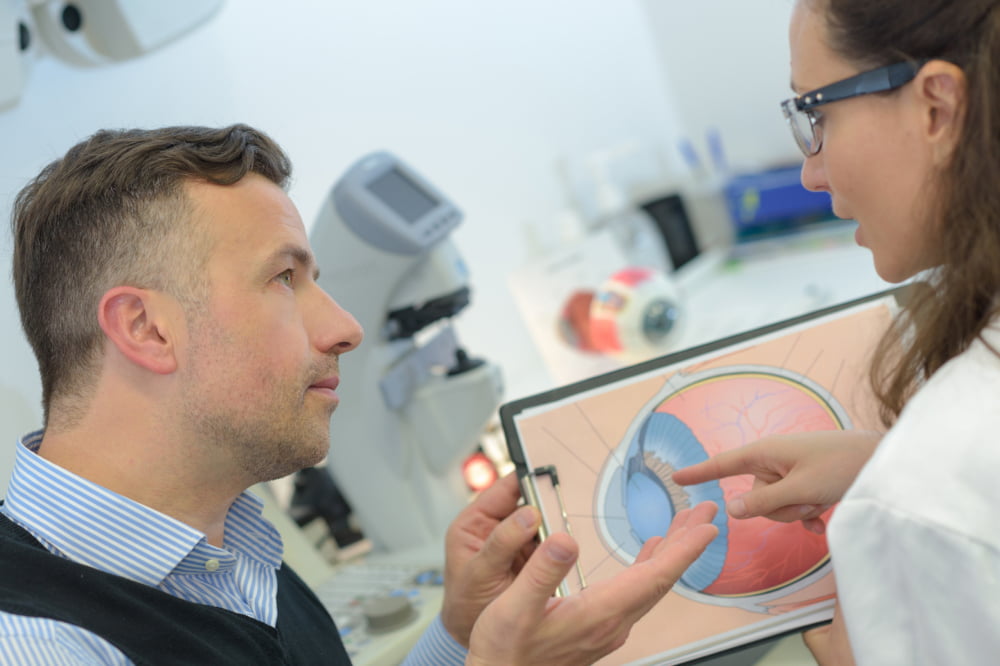
Macular degeneration – Causes, types, signs, and management
Macular degeneration is a common eye disease that can blur central vision, making it difficult to see fine details. The condition usually develops with age due to damage to the macula—the part of the retina responsible for straight-ahead and sharp vision. Though it does not cause complete vision loss, blurred or distorted vision associated with AMD can affect the ability to carry out daily tasks. Here is what one should know:
Causes
Experts believe that age is the leading cause of macular degeneration, which is why it is often called age-related macular degeneration or AMD. However, there are various risk factors that could make one more susceptible to the condition. For instance, a high intake of saturated fats, such as those found in butter, meats, and cheese, can increase the risk of developing this disease. Others at a higher risk of age-related macular degeneration are people over the age of 50, those with hypertension (high blood pressure), and those with a family history of AMD. Heart disease can also increase the risk of developing or worsening this degenerative eye disease.
Types
There are two types of age-related macular degeneration, wet and dry. Here is a look at each one:
Dry AMD: Dry (atrophic) AMD develops as the macula gets thinner with age. This type of degenerative disease occurs in three stages—early, intermediate, and late, and the condition progresses gradually over many years. In addition to seeking treatments to manage the condition, those dealing with dry AMD could look for ways to save and work with the rest of their vision. Those who develop dry AMD in a single eye could take measures to protect the other eye from developing similar symptoms.
Wet AMD: Also known as advanced AMD, this is a type of late AMD but could result in faster vision loss. While dry AMD at any stage can transition to wet AMD, the latter always develops in the late stages. This type is associated with macular damage due to the growth of abnormal blood vessels in the rear section of the eye. One should note that, like dry age-related macular degeneration, wet AMD can also be managed with prescription treatment and other options.
Symptoms
The symptoms of dry and wet AMD vary based on the stage. Dry age-related macular degeneration may develop in its three stages. Moreover, as AMD is a progressive disease, the symptoms generally worsen with time. One should note:
- People with early dry AMD do not develop any symptoms.
- With intermediate dry AMD, few may have no symptoms, while others might notice mild symptoms like blurred central vision or difficulty seeing in low-lighting conditions.
- People with late-stage AMD (wet or dry type) may notice straight lines turning crooked or wavy. Those affected by this stage may also notice a blurry spot near the center of vision. This blurred region may get bigger or blank spots may begin developing as the disease progresses. Further, one may find that colors look less bright than usual and experience trouble seeing in low-lighting conditions.
If one notices any of these signs, they should consult an eye doctor and seek appropriate treatment immediately.
Treatment
There is no treatment for early AMD, and experts generally keep track of how the eyes are doing with regular eye exams. Later, the treatment for AMD will differ based on the stage and type of condition. People with wet age-related macular degeneration might need different types of treatments, like photodynamic therapy, where a specialist uses a combination of prescriptions and laser to eliminate the additional blood vessels in the eye. This method may also be combined with another treatment option based on the complexity of the disease.
The eye specialist might also suggest laser photocoagulation to treat wet age-related macular degeneration. Here, a laser is used to seal and remove the leaking blood vessels.
For those with late dry AMD, treatment options are still in the works. While AMD has no permanent cure, treatment can help slow down disease progression.
Natural remedies
In addition to treatment, experts may also suggest making the following lifestyle changes to help patients prevent worsening the condition and deal with symptoms:
- Eating healthier foods, such as dark leafy greens like spinach, bright fruits, and fish, can help one get the necessary nutrients to improve overall health. One should choose foods high in antioxidants, fibers and those rich in vitamins A, C, and E.
- Regular exercise could help pump more oxygenated blood to various organs of the body, including the eyes.
- Drinking plenty of water can help the eyes stay hydrated and flush out any debris.




